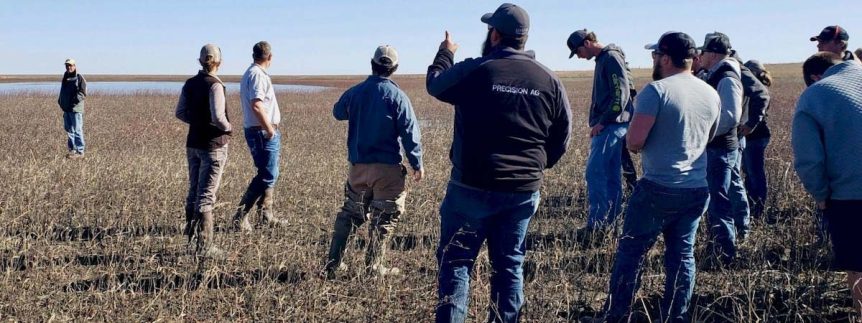A group of precision agriculture students in Kansas are taking part in the conversation of how best to restore playas and use new technology to advance existing efforts. Educating the next generation of producers about playas is an important step to ensuring the continued conservation of these wetlands and the recharge value to the Ogallala aquifer.
“I think it’s important to reach out to these students because they are going to be the decision makers in the future,” said Abe Lollar, a biologist from Ducks Unlimited who recently met with the students. “If we don’t show examples of the benefits of conservation or inform future producers, land managers and landowners about the importance of playas and the important role they play in groundwater recharge, water quality, soil health, and wildlife conservation, we will be taking steps backwards.”
Many of these students will eventually be taking over farm efforts and, in the meantime, they are taking this new information and these new ideas back to their grandparents and parents who are currently farming the land.
In October, Lollar led a group of 30 students from Northwest Kansas Technical College in Goodland, Kansas on a tour to look at playas and discuss existing programs as well as the potential of technology and conservation to come together to restore and conserve elements of landscapes such as playas. The students saw playas in four different types of fields: one in the Conservation Reserve Program (CRP) and one that had expired, another was enrolled in a Wetland Reserve Easement (WRE), and the last one was not enrolled in a conservation program.
“The students didn’t know the mechanics and everything that was going on in a playa,” said Weston McCary, director of Precision Agriculture and Unmanned Aerial Systems at the college. “They didn’t understand playas are playing a greater role in a bigger ecosystem and didn’t realize how much was pending on these little bodies of water existing.”
McCary, who worked to bring Lollar, Brittany Smith from Pheasants Forever and Abby Athen from the Kansas Department of Wildlife and Parks to the college to talk with students, said it was a positive experience seeing the students so engaged in the conservation conversation.
“They’ll be at the front edge of the early adopters of conservation practices and the sooner that we have more people adopting, the less desperate the problem becomes,” McCary said. “These students want to be able to leave that legacy. They’re not fully in control of that now but it’s in their heads and hearts. They’re talking about it.”
A large part of the discussion during the tour and after focused on how precision agriculture and new technology can inform better conservation practices and how the two can go hand in hand. During the playa tour and presentation, Lollar said lightbulbs seemed to be going off in the students’ minds as they started to think of ways they could incorporate playa conservation into their farming practices.
The group talked about the potential to use technology such as drones to spray for invasive plants and using dry spreaders to reseed playas that may need a boost of a certain plant. Electromagnetic mapping equipment could also be used to map playas and pair the findings with GIS systems to better understand the efficiency of the land.
“It was good conversation and out-of-the-box thinking,” Lollar said. “These students are forward thinking and are looking toward the future of water, wetlands, farming, ranching, and wildlife conservation, which is why Ducks Unlimited and our partners wanted to talk with these students.”
Many of these students will eventually be taking over farm efforts and, in the meantime, they are taking this new information and these new ideas back to their grandparents and parents who are currently farming the land.
“When you put those things out there, they may not come into play tomorrow, they may not even come into play a year or five years from now, but at some point they will come into play in people’s lives,” McCary said. “That’s how you change things.”

